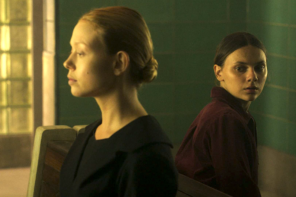A demon guides you through the shadows. The bodies of teenagers are strewn about like broken dolls in the mangled remains of a car, bottles of Jim Beam tellingly scattered about the wreckage. A young woman sits steeped in her own blood, surrounded by what looks like modern medical equipment in a women’s clinic but dying from a “botched abortion” anyway. Finally, an angry voice from a glowing figure shrouded in white orders you off into hell, a basement room where scenes, the likes of which Clive Barker dared not dream, swirl out of the dry ice. Male S&M Demons whip teenage girls who cry out in pain and despair.
These are maybe not the kinds of things you’d expect to see on a crisp fall evening at your local evangelical church. Still, in the 1990s, tens of thousands witnessed these scenes at church sponsored attractions known as “Hell Houses.” Born out of anxiety over the allegedly satanic meanings of Halloween and the desire to convert souls, evangelical churches created these “Christian Haunted Houses” to convince children and adolescents of the reality of the last judgment and damnation. Instead of unquiet spirits, vampires, and chainsaw-wielding madmen, the vengeful ghosts of the culture wars haunted these Houses.
Abundant Life Christian Center in Colorado created one of the first, most successful, and most controversial Hell Houses. Attempting to be as edgy as possible, Abundant Life actually used animal intestines to represent an aborted fetus in the stock “women’s clinic” scene. Gruesome effects such as these proved successful enough to allow Abundant Life to package and franchise their effort, creating a 280-page guide explaining how other evangelical churches could create their own Christian horror show. Hell houses spread throughout the Southern and Western United States garnering lots of attention and claiming plenty of converts. In 2001, filmmaker George Ratliff took notice of the phenomenon in his wonderfully rendered documentary Hell House.
In the last decade, a new version of the Hell House, a softer and gentler version, has appeared known as “Judgement House” (yes, always judgement with two ‘e’s). Judgement House, which specifically presents itself as a remodeled Hell House, points out that Hell Houses tend to deal with “socially controversial issues such as homosexuality, date rape, and suicide.” In contrast, Judgement House claims to avoid such topics preferring, according to its FAQ section, to “show participants the consequences of choosing the gift of eternal salvation… as well as experiencing a small part of the separation from God in hell that is the consequence of rejecting that same gift.”
Although the Judgement House scripts do make a conscious effort to avoid the language of the culture wars, the symbols are still present and powerful. One of their scripts entitled “Home of the Brave, Land of the Free” tells a story of conversion against the backdrop of the Iraq War. An online preview of the script suggests that the narrative marries jingoism with true piety, portraying the heroes of the script, Corey and Kevin, as “living their dream of defending the country they love,” having gone to Iraq to “love and serve Jesus Christ, the Hero of all mankind.”
This obviously suits the post-9/11 mood of many evangelicals in which America’s wars are God’s wars and God’s heroes are America’s heroes.
Cultural sewage of the type that Nancy Grace built her career transmitting also plays a significant role in other Judgement House narratives. Adult predators are a persistent concern of the scripts with two of them (“Web of Lies” and “Abducted”) centering on the kidnapping of teenage girls. “Web of Lies” opens with a story of a man’s death in an electric chair, the outcome of his predatory behavior on the Internet, while another portrays a Columbine-style school shooting as the inevitable outcome of a rejection of evangelical Christian doctrine.
It is, of course, disingenuous to claim that narratives concerned with the Iraq War, sex and the internet, and school violence avoids cultural symbols. Moreover, Judgement House can be as graphic as the Hell Houses; for starters, you get a tour of a hell [warning: videos may be disturbing] with low production values whichever you choose. Not unlike the Hell Houses, they manage to put together the strangest and most unappealing images of heaven (in this next clip be sure to catch the guy in the Michigan jersey getting a bear hug from Jesus at 2:04) and the most infantile images of hell you can imagine.
It is true that the messages are often much more implicit, suggesting that the Judgement House phenomenon can be interpreted very much an outgrowth of the megachurch movement, with its sometimes fuzzy and amorphous appeal to “attend church wearing shorts” and “drink a latte during the worship service” masking a profoundly fundamentalist theological and cultural message.
Perhaps the most notable example of Judgement House’s conservative cultural message is in its portrayal of women. The performances exude a patriarchal ethos, subtly and sometimes not so subtly communicating messages about women and girls. Almost all of the women in the scripts are victims of men and the scripts actually call for several of them to die at the hands of their attackers. The one script that makes a woman a central figure (“Hannah’s Hope”) still makes her a victim. Hannah is dying of a brain tumor but not before God gives her one final grace: she gets to become Homecoming Queen of her high school. To quote from the official Judgement House Web site’s description of the narrative: “our homecoming Queen went home for eternity to be with her King, Jesus Christ.”
In some respects, the Judgement House phenomenon carries much more subtle power than the Hell Houses, even as they are less overtly political. The Hell Houses were gaudy and gothic, a fantasy universe where you felt you were being pursued by a Cosmic Torturer chasing you through harrowing vignettes drawn from the labyrinth of the anxious conservative psyche. The world of Judgement House is less fantastical, more closely tied to the supposedly safe suburban world inhabited by the majority of the youths who attend them. It is that world of soccer moms and patriarchal traditions, youth groups and church activities, mission trips and Christian music, that offers safety and security. The message of Judgement House is that beyond this world, and beyond the simplistic theology they offer, lies nothing but madness, death… and hell.
Happy Halloween everybody.




